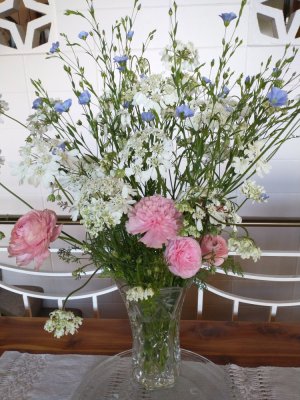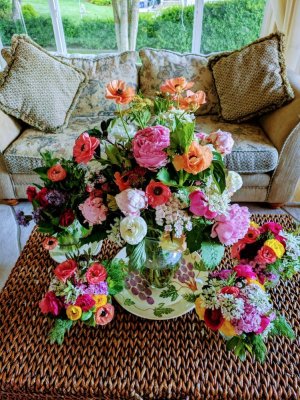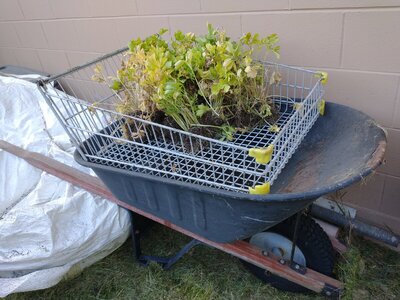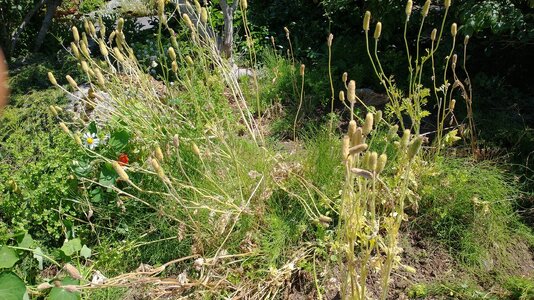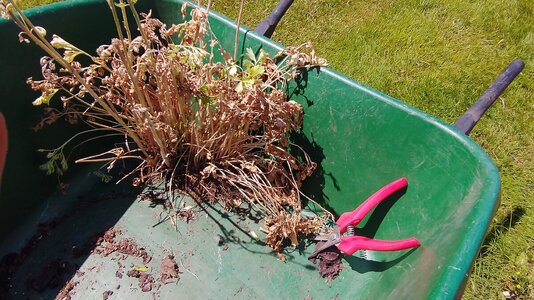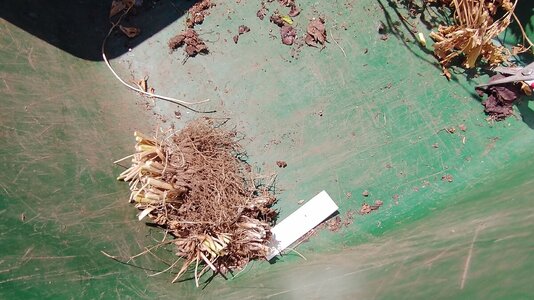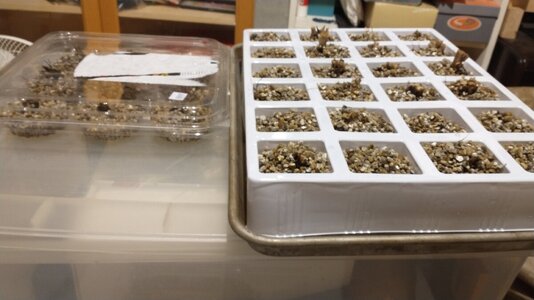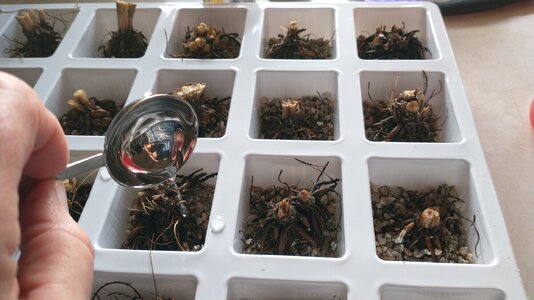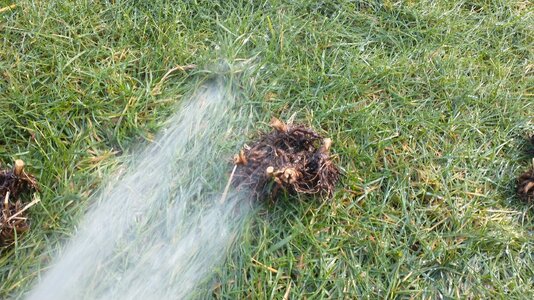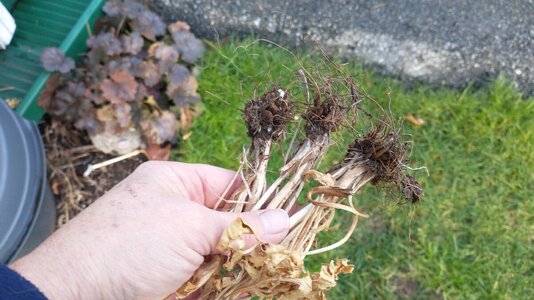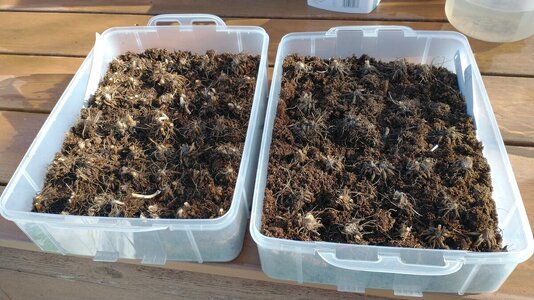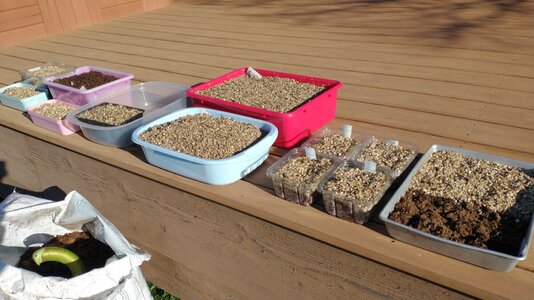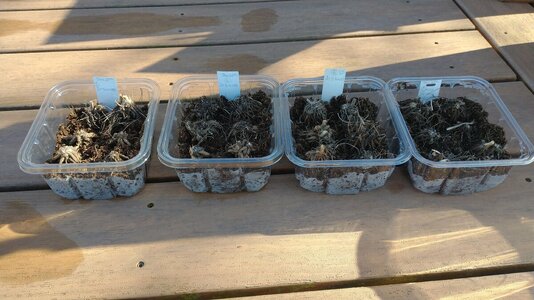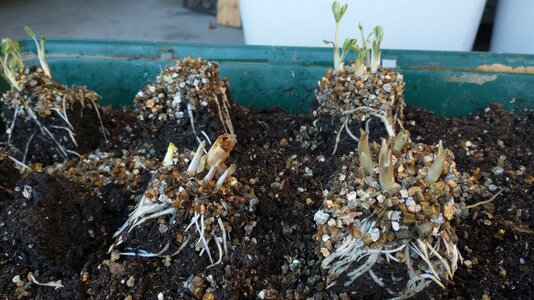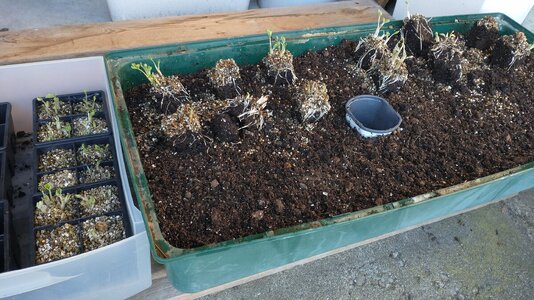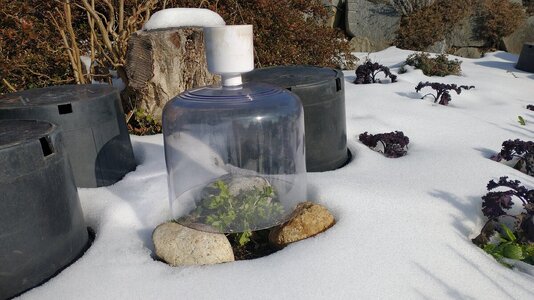- Thread starter
- #51
You are using an out of date browser. It may not display this or other websites correctly.
You should upgrade or use an alternative browser.
You should upgrade or use an alternative browser.
Ranunculas
- Thread starter Branching Out
- Start date
- Thread starter
- #52
Branching Out
Garden Addicted
Yesterday morning I harvested flowers and greenery, and got them in buckets of cool water to hydrate. Then I spent several hours in the afternoon making arrangements. My husband has a new phone that makes it easy to add a cool or warm tone to photos, so I used that to photograph the results. There are five bouquets in this shot, with a large one in the centre and four smaller ones beside it.
Attachments
- Thread starter
- #53
Branching Out
Garden Addicted
One patch of Ranunculas has finished blooming and the leaves have turned yellow. You're supposed to wait for the leaves to turn brown before you lift and store the corms, but I wanted to flip the bed to pickling cucumbers and tomatoes so I removed them from the ground anyway. There was an old grocery cart basket hanging around and that became my drying rack. I placed the rack over a wheelbarrow and was able to fit quite a few clumps of corms in it; there should be lots of air circulation for drying down. We had rain after that, and the clumps stayed nice and dry in their spot close to the house.
Attachments
Last edited:
- Thread starter
- #54
Branching Out
Garden Addicted
The last few patches of ranunculas have dried down, and now that the foliage is mostly gone they are very easy to lift from the ground. I trimmed their stems, leaving about 2". Having some stems attached will make it easier to figure out which way is 'up' come spring. After trimming I tossed them on the lawn and gave them a good rinse with the hose to remove most of the dirt. The cleaned corms will sit in the shade on nursery trays to dry for a week or two, and then they'll go back into paper bags or cardboard boxes for winter storage in a cool, dark spot indoors. My ranuncula season is complete-- and it was a great ride! 
Attachments
- Thread starter
- #55
Branching Out
Garden Addicted
Here we go again-- a new year, and a new season of growing ranunculus. The corms that I planted last spring multiplied exponentially, so now there are lots of extras to experiment with. This year I am starting some several weeks earlier than in past years, and instead of placing them in potting mix I am trialling pre-sprouting them in vermiculite instead. Also, the first batch I soaked for a few hours to wake them up, but the second batch just got a quick rinse with the hose before being tucked into damp vermiculite. If they can pre-sprout without soaking for several hours first I will be really happy, as the soaking step can be kind of messy.
For now they are sitting in our cold, dark basement with a loose layer of row cover over them to hold in a bit of extra humidity.
For now they are sitting in our cold, dark basement with a loose layer of row cover over them to hold in a bit of extra humidity.
Attachments
- Thread starter
- #56
Branching Out
Garden Addicted
It was time to move a batch of corms that were pre-sprouted about 12 days ago outdoors into deeper containers. They had developed such broad white roots that they required twice as much space as compared to the first stage, where they were snugged in shoulder to shoulder in a couple of inches of vermiculite. The bigger bins were prepped with compost, peat moss, and dry organic fertilizer. I tucked the sprouted corms on top of the peat mix, and then covered them in vermiculite again. There are now two bins of each variety, so one of each will sit under cover on our sundeck, and one of each will go to our friend's hoop house to see if the extra warmth there helps get them off to a better start.
Then the last two boxes of dormant corms were sorted, rinsed, and set in trays to pre-sprout indoors (update: decided to leave them on the sundeck in a dark sack instead). This batch will have a layer of peat and compost under the corms and vermiculite on top right from the start. I gave them a bit more space to plump up this time, in the hopes that they can go directly from the tray to being planted in the ground in about three weeks time-- so I don't have to handle them twice. There were also a few extras for sharing, which is always nice.
Then the last two boxes of dormant corms were sorted, rinsed, and set in trays to pre-sprout indoors (update: decided to leave them on the sundeck in a dark sack instead). This batch will have a layer of peat and compost under the corms and vermiculite on top right from the start. I gave them a bit more space to plump up this time, in the hopes that they can go directly from the tray to being planted in the ground in about three weeks time-- so I don't have to handle them twice. There were also a few extras for sharing, which is always nice.
Attachments
Last edited:
- Thread starter
- #57
Branching Out
Garden Addicted
Another bin of ranunculus on the move. I had planned on planting them out in the garden-- but cold weather is finally going to arrive later this week. So for now these ones are tucked into a large seedlings bin so they can continue to develop unfettered in our carport for extra protection. I had neglected to water this bin over the winter, so the peat-based potting mix was bone dry. It sure takes a long time to rehydrate it once it gets to that state.
Attachments
ducks4you
Garden Master
- Joined
- Sep 4, 2009
- Messages
- 13,247
- Reaction score
- 20,186
- Points
- 437
I saw a special on Mid American Gardener a few months ago, where the host visited a local small farm, where they grow flowers. The owner said that 85% of flowers that are purchased in the USA are imported, and she has found a local and expanding niche, so, My zone.
She succession plants her ranunculas bulbs in the fall to be ready for market sale in the Spring, in her unheated greenhouse.

 www.pbs.org
www.pbs.org
She succession plants her ranunculas bulbs in the fall to be ready for market sale in the Spring, in her unheated greenhouse.

Mid-American Gardener | December 5, 2024 - Mid-American Gardener | Season 14 | Episode 16
Mid-American Gardener - December 5, 2024 - Delight Flower Farm
Last edited:
- Thread starter
- #59
Branching Out
Garden Addicted
I may experiment with fall planting in my friend's hoop house come autumn-- but it's far too cold here to plant them in the fall without that kind of protection. Having said that, this year several ranuncula plants have popped up from corms that I neglected to lift last June, and they look to be thriving. I suspect that they will all perish next week when an arctic front moves in (and if not, I will make sure to mark them as cold-tolerant specimens).
Ducks, I highly recommend reading Amy Stewarts book Flower Confidential. It really makes you appreciate flower breeders and flower farmers, while shining a light on how far some blossoms travel before they make it into a bouquet that we purchase at the grocery store. Each chapter is an interesting vignette-- and there is an especially charming chapter on the development of the Star Gazer Lily.
Ducks, I highly recommend reading Amy Stewarts book Flower Confidential. It really makes you appreciate flower breeders and flower farmers, while shining a light on how far some blossoms travel before they make it into a bouquet that we purchase at the grocery store. Each chapter is an interesting vignette-- and there is an especially charming chapter on the development of the Star Gazer Lily.
- Thread starter
- #60
Branching Out
Garden Addicted
I moved my Purple Jean ranuncula corms to bins of potting mix yesterday. Only half of them had sprouted, and I had been watering them to try and wake them up. Well, it turns out that the ones that didn't sprout were sitting in pools of water, and they rotted. Hopefully I can remember this next year, so I don't drown the corms again by accident.
On a positive note one ranuncula that is overwintering in the garden from last season continues to thrive, despite frigid temperatures. I found a clear acrylic dome that I am using as a cloche to protect it. We have very cold night time lows forecast for the week ahead, and then after that the weather should warm up considerably.
On a positive note one ranuncula that is overwintering in the garden from last season continues to thrive, despite frigid temperatures. I found a clear acrylic dome that I am using as a cloche to protect it. We have very cold night time lows forecast for the week ahead, and then after that the weather should warm up considerably.

